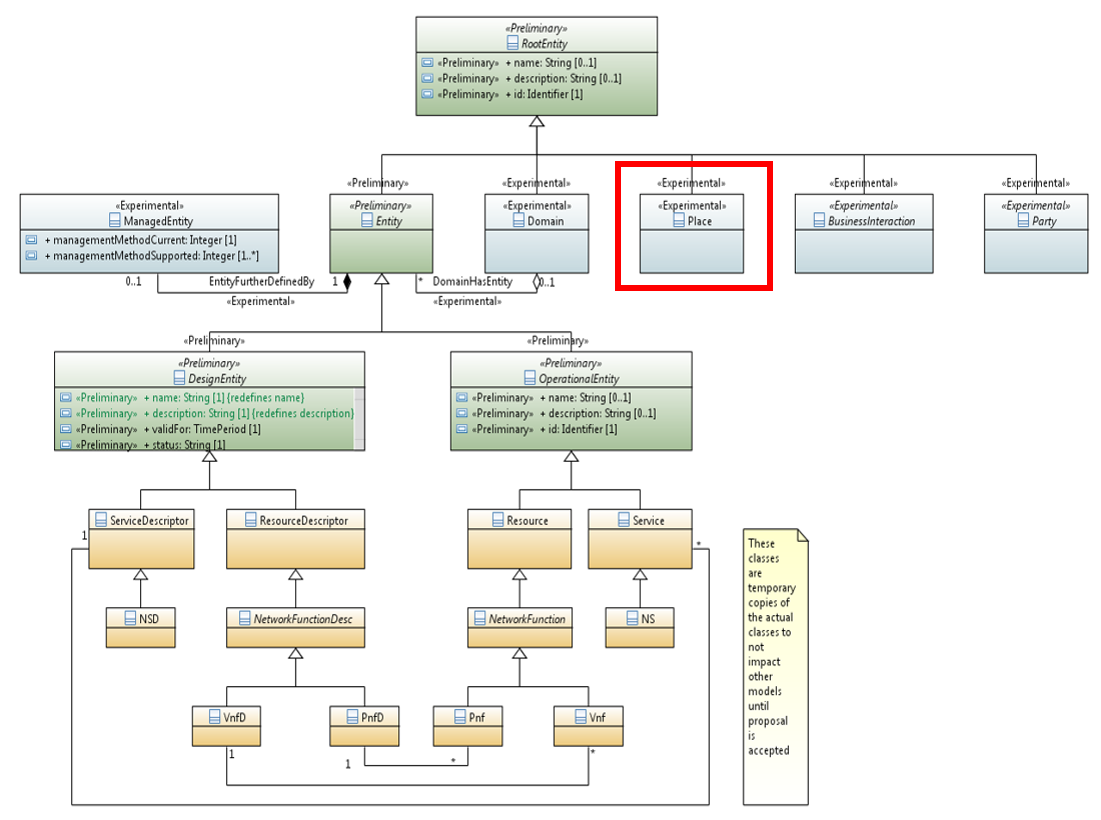...
| Section | Description | ||||||||||||||||||||||||||||||||||||||||||||||
|---|---|---|---|---|---|---|---|---|---|---|---|---|---|---|---|---|---|---|---|---|---|---|---|---|---|---|---|---|---|---|---|---|---|---|---|---|---|---|---|---|---|---|---|---|---|---|---|
Information Element Name | Place Object | ||||||||||||||||||||||||||||||||||||||||||||||
| Points of Contact | Information Element Main Contact - Benjamin Cheung , Jacqueline Beaulac [Ericsson] Information Modeling Contact - Benjamin Cheung , Jacqueline Beaulac [Ericsson] Schema Definition Contact - Benjamin Cheung , Jacqueline Beaulac [Ericsson] | ||||||||||||||||||||||||||||||||||||||||||||||
| Related Use Cases | The Place object for PNFs will first be used in R7 by the OOF / SON / PCI Use case WIKI PAGE: R7 OOF SON Use Case Main Contacts: Swaminathan Seetharaman , N. K. Shankar | ||||||||||||||||||||||||||||||||||||||||||||||
Participating ONAP Components | Main components affected are: PRH (PNF Registration Handler), DCAE, OOF SON PCI Use Case Micro-service | ||||||||||||||||||||||||||||||||||||||||||||||
| Related JIRA |
| ||||||||||||||||||||||||||||||||||||||||||||||
Description | The development of the PLACE object will introduce the ability to associate generic "place" (location) information to xNFs. The discussion pages for model development are here: PNFD/SDC AID/AAI Schema Modeling/5G Svc Model - R7 Discussion | ||||||||||||||||||||||||||||||||||||||||||||||
Related Standards & Industry Activities | Related Industry Standards are here:
| ||||||||||||||||||||||||||||||||||||||||||||||
Attributes | The fields are described here in this document: PNFPlaceModel_202007Jy02.xlsx
| ||||||||||||||||||||||||||||||||||||||||||||||
Relationships | Relationships: Describe how this Information Element is related to other Information Elements. Also describe nature of the relationship: association, inheritance, dependency, etc. and multiplicity. *** NOT SURE HOW TO FILL OUT *** | ||||||||||||||||||||||||||||||||||||||||||||||
Originator | DESIGN TIME - services are declared with resources (xNFs). xNFs would associate with PLACE information. Cells (logical objects) in C&PS DB would associate with the PLACE information. RUN TIME - xNFs are instantiated. PNF register. At the point of registration PLACE information is set. RUN TIME - OOF SON PCI - Logical objects, cells associated with the PNF will set PLACE information. | ||||||||||||||||||||||||||||||||||||||||||||||
| Consumers | PNF Plug and Play Use Case (Inside ONAP) - The Plug and Play use case describes the process that a PNF performs when it tries to register with ONAP. This means that during installation & commissioning, ONAP needs to set the PNF Place information. This would likely not be reported by the PNF itself, but would be cross-correlated with the PNF resource instantiation during SO BPMN/WF/BB execution. OOF SON PCI Use Case (Inside ONAP) - The OOF SON PCI Use Case is an existing Use Case that was started in R3 Casablanca. It has continued to develop throughout R4, R5 and R6. This Use Case is all about PCI location and cell location. Which requires location and place information to be associated with the cell logical object. External Apps tracking location (Outside of ONAP to External APIs). Who uses this information inside & outside of ONAP? How do they use it? Includes description of information consumed (whole class, specific attributes, etc.) | ||||||||||||||||||||||||||||||||||||||||||||||
Producers | PNF Plug and Play Use Case (Inside ONAP) - This would likely be updated during PnP registration for the PNF resource instantiation during SO BPMN/WF/BB execution. OOF SON PCI Use Case (Inside ONAP) - This information is updated when the PCI micro-service excutes. It needs to know about neighbors and cell locations. When setting up its data it needs to know the relatively location of cells. Who updates this information inside & outside of ONAP? Under what conditions do they update it? Includes description of information produced (whole class, specific attributes, etc.) | ||||||||||||||||||||||||||||||||||||||||||||||
Steward | PNF Plug and Play Use Case (Inside ONAP) - The geolocation information should be captured in an instantiation of the PLACE object. The PNF instance should associated with this object. OOF SON PCI Use Case (Inside ONAP) - The geolocation information should be captured in an instantiation of the PLACE object. The PNF instance should associated with this object. Where will this information stored and maintained in ONAP? | ||||||||||||||||||||||||||||||||||||||||||||||
| Impacted APIs & Schemas | PNF Plug and Play Use Case (Inside ONAP) - The SO API for BB should be impacted. OOF SON PCI Use Case (Inside ONAP) - The C&PS API will be impacted, which is where the PCI Use Case stores informaiton Identify impacted ONAP schemas & APIs Are there existing schemas be used or extended? | ||||||||||||||||||||||||||||||||||||||||||||||
Information Modeling Status | This is scheduled in the R7 Modeling planning page. The Wiki page: ONAP R7 Modeling High Level Requirements It is being tracked by the Modeling-368 Jira which can be found here:
What is the status of ONAP Information Modeling activities associated with this Information Element. Please provide links to relevant wiki pages & JIRA. | ||||||||||||||||||||||||||||||||||||||||||||||
Schema Definition Status | What is the status of ONAP Schema Definition activities associated with this Information Element. Please provide links to relevant wiki pages & JIRA. | ||||||||||||||||||||||||||||||||||||||||||||||
ONAP Release Priority | R6 Frankfurt - Experimental model introduction of Place Object was introduced by Kevin Scaggs R7 Guilin - Model introduction of Place used by OOF SON PCI U/Cshould be developed. |
